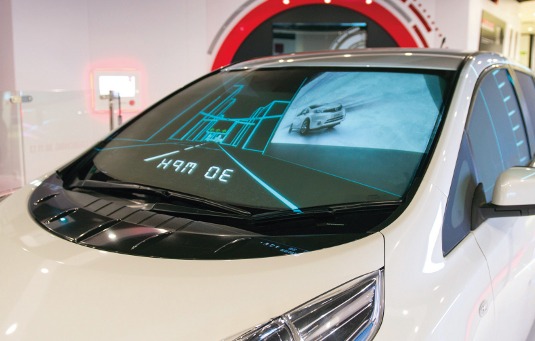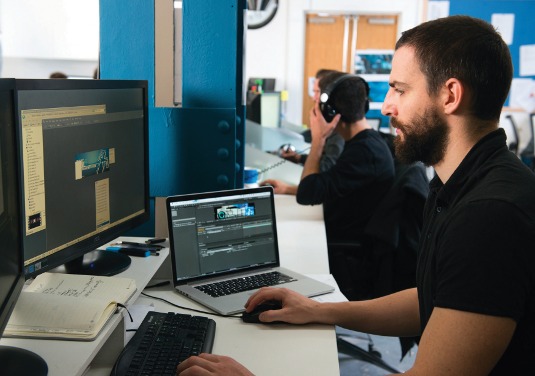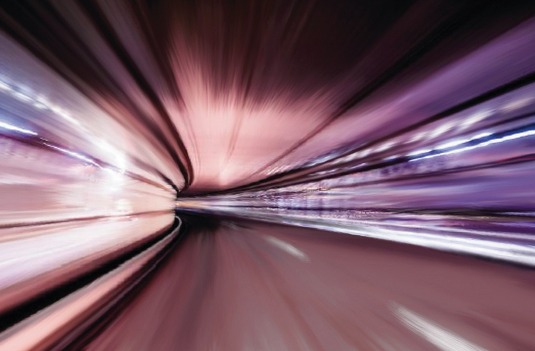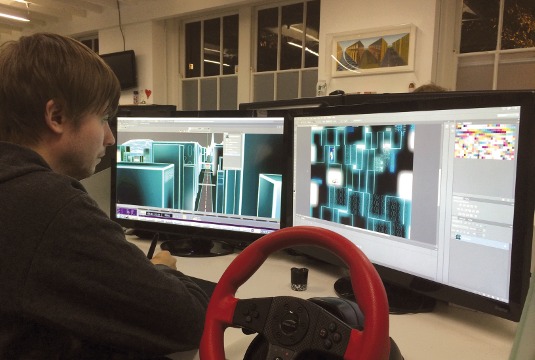How to Test a Used Car Before Buying
How to take a real car out for a virtual test drive
TRO Group commissioned Projection Advertising to create a permanent installation at the Nissan Innovation Station in London's O2 Arena, showcasing the Nissan Leaf electric car. The aim was to use projection mapping and real-time rendering to create an authentic, immersive driving experience that would highlight the car's selling points.
The initial brief was quite loose because the client wanted to get our most creative ideas. How could we design a cool experience to show off the Nissan Leaf? The idea of projecting onto the windows developed from that point onwards.
We then got the full brief to design and make an interactive experience for the public to view in the Nissan Innovation Station area of the O2 Arena in London. Nissan wanted people to experience the car, see that it provides a normal driving experience while being quieter than any non-electric vehicle, and – in keeping with the advertising for the Leaf – to "feel the surge" of accelerating.
We made style references in Photoshop for the city and landscape. The environment is realistic, but stylised in a futuristic, electronic way. The basis for the look and feel came from the fact that the car is electric, while the colour scheme was inspired by the Leaf's blue branding. We had a lot of contact with the car so we all knew what it was like to drive it.

Work in progress
After initial concepting, we created matte paintings and refined the look and feel while doing tests to work out how the car would function within the virtual environment. The landscape is almost energetic, with power lines moving around – we're using electricity in a fairly literal way.
Users can choose from three routes by taking different turns at the traffic lights, encouraging them to put their foot down and accelerate again. Three London landmarks point them in the right direction: Battersea Power Station, The Shard and Tower Bridge.

To start with, we built 3D wireframe models of the city to create the journey layout, then painted directly onto the 3D models in 3D-Coat. Rather than having the light affect the environment in 3D, we put in traditional compositing techniques after it had been rendered, keying out areas and using that to create light lines. The graphics are all rendered in real time apart from the introduction, but we wanted to ensure we achieved the quality of pre-rendered content.
We used TouchDesigner for almost every aspect of the project, from bringing in 3D geometry and compositing to standard things you might normally do in Nuke. It's a very efficient, powerful platform and is great for communicating between devices. We built in some physics to allow the car to move around – the environment responds to steering, acceleration and braking as you drive along the rolling road, which functions like a treadmill.

We started out using an Xbox 360 controller to check we had the basic functions – left, right, forward – in place, then moved onto a PC game steering wheel. The actual car provided very different information and moved away from any kind of arcade game feel.
Using rear projection from outside the car meant we were essentially reversing the images. We used a rear projection film, a bit like vinyl but slightly more rigid, which provides a wider viewing angle. When we made changes on-site, we were effectively working with backwards content.

Conclusion
Turn left or right at the junction rather than driving straight on and the environment swings round to meet you – a much more efficient way of doing things. You drive into a tunnel where you're asked to really put your foot down, then you arrive back at the O2. That final part of the drive was based on photos of the actual room.
The idea was to show people that you can leave the city and come back within one battery charge, showcasing the fact that the Nissan Leaf has an impressively long charge. You can see the projected content from outside the car as well. While the experience is primarily for the driver and passengers, we wanted to entice people by giving them a preview.

This is a novel way of enabling people to experience the car without actually taking it out for a test drive. Projecting a virtual world onto the windscreen and side windows makes for a very immersive experience. It's really reactive – you're pressing the accelerator, steering round corners and choosing which way to turn, so it's about as real as a virtual test drive could get.
Words: Lizzy Chase and Richard Burns
This article originally appeared in Computer Arts issue 222.
Liked this? Read these!
- The best 3D movies coming in 2014
- Discover what's next for Augmented Reality
- How to build an app: try these great tutorials
Related articles
How to Test a Used Car Before Buying
Source: https://www.creativebloq.com/3d/how-take-real-car-out-virtual-test-drive-11410549
0 Response to "How to Test a Used Car Before Buying"
Post a Comment